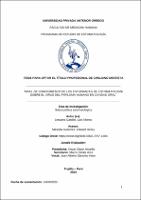Nivel de conocimiento de los estudiantes de Estomatología sobre el virus del papiloma humano en cavidad oral

Ver/
Descargar
(application/pdf: 1.776Mb)
(application/pdf: 1.776Mb)
Fecha
2023Autor(es)
Lescano Castillo, Luis Alonso
Metadatos
Mostrar el registro completo del ítemResumen
Determinar el nivel de conocimiento de los estudiantes de estomatología sobre el virus del papiloma humano en cavidad oral.
Material y método: La investigación fue observacional y con diseño de tipo transversal, aplicando un cuestionario de manera virtual, desarrollado en 20 preguntas, las cuales fueron valoradas con la escala de Likert, se evaluó a 125 estudiantes de la Escuela de estomatología de la Universidad Privada Antenor Orrego. Se utilizó la prueba estadística chi cuadrado con un nivel de significancia del 5%.
Resultados: El nivel de conocimiento de los estudiantes de estomatología sobre el virus de papiloma humano en la cavidad oral según ciclo, fue predominante el nivel de conocimiento insuficiente en octavo ciclo (87%), noveno ciclo (84%), decimo (74.54%), seguido del nivel de conocimiento suficiente en octavo ciclo (13.33%), noveno ciclo (12%), decimo (23.63%) y finalmente el nivel de conocimiento bueno en noveno ciclo (4%), decimo (1.81%).
Conclusiones: El nivel de conocimiento de los estudiantes de estomatología de la Universidad Privada Antenor Orrego sobre papiloma humano en cavidad oral fue insuficiente, predominando en octavo ciclo y en ambos sexos. To determine the level of knowledge of dentistry students about the human papilloma virus in the oral cavity.
• Material and method: The research was observational and with a cross-sectional design, applying a questionnaire in a virtual way, developed in 20 questions, which were evaluated with the Likert scale, 125 students of the School of Stomatology of the Antenor Orrego Private University. The chi square statistical test was performed with a significance level of 5%.
• Results: The level of knowledge of the stomatology students about the human papilloma virus in the oral cavity according to cycle, the level of insufficient knowledge was predominant in the eighth cycle (87%), ninth cycle (84%), tenth (74.54%), followed by the sufficient level of knowledge in the eighth cycle (13.33%), ninth cycle (12%), tenth (23.63%) and finally the good level of knowledge in the ninth cycle (4%), tenth (1.81%).
• Conclusions: The level of knowledge of the stomatology students of the Antenor Orrego Private University about human papilloma in the oral cavity was insufficient, prevailing in the eighth cycle and in both sexes.
Palabras clave
Colecciones
- Estomatología [653]

